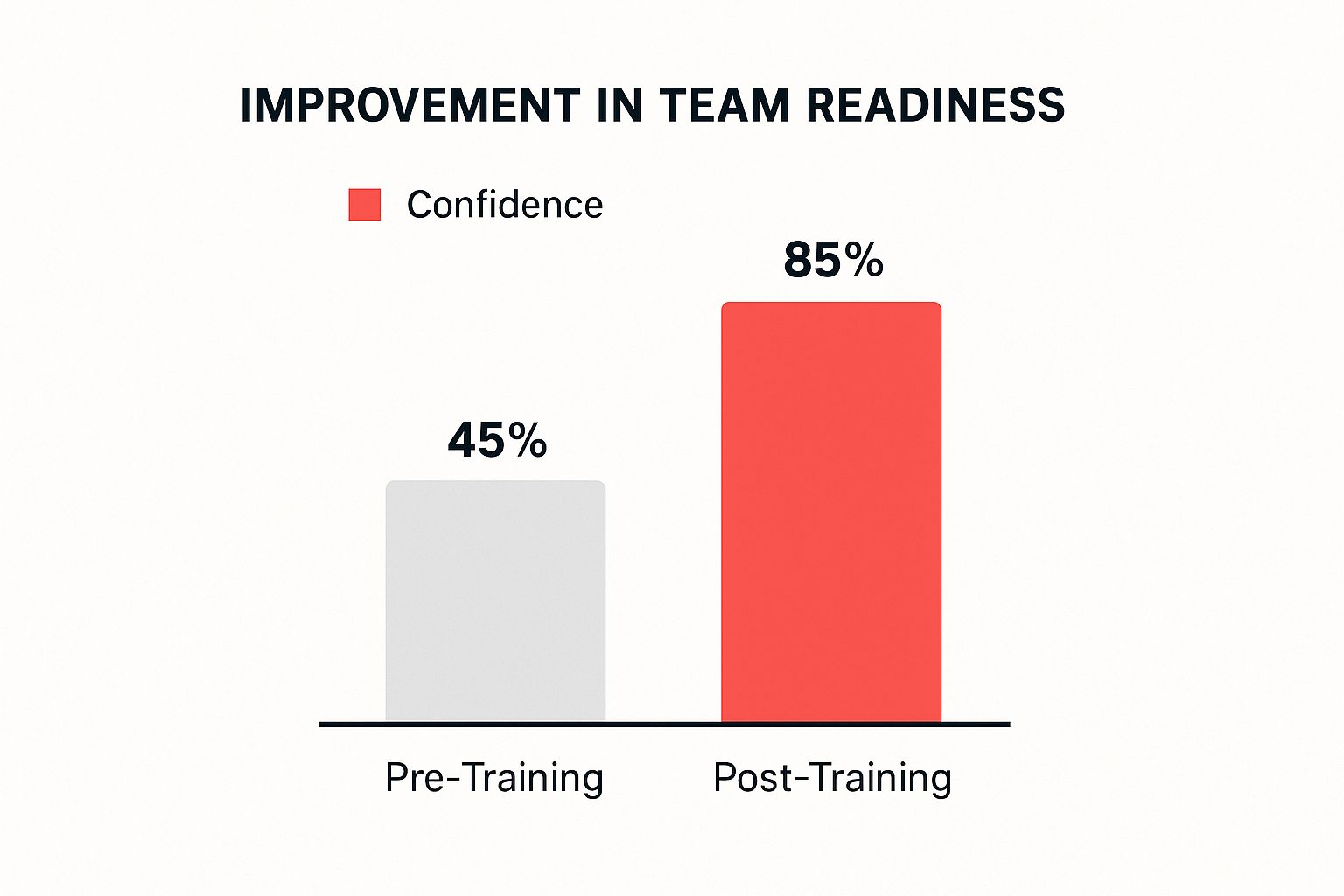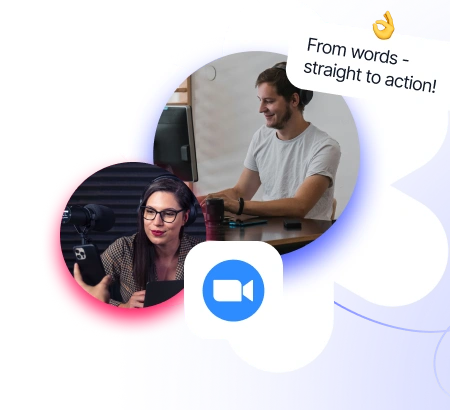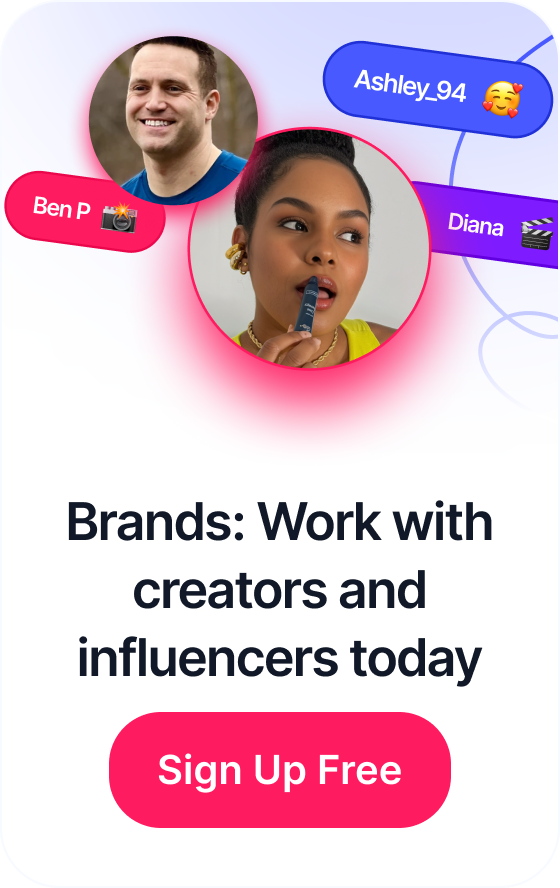 A Marketer’s Guide to Earned Media Value
A Marketer’s Guide to Earned Media Value
So, what exactly is a new product launch strategy? Think of it as the detailed battle plan that takes your product from a great idea to a massive success in the market. It’s the roadmap that gets your marketing, sales, and product teams all marching in the same direction to build hype, nail those initial sales, and create momentum that lasts. The best ones are always built on a deep understanding of the customer and backed by real data.
Table of Contents
Building Your Foundation for a Winning Launch

The heavy lifting for a killer product launch happens way before the public even knows you exist. This foundational stage is where you move from daydreaming to doing the real work that separates breakout products from expensive flops. It’s all about validating your gut feelings and building a plan based on hard evidence, not just pure excitement.
Too many brands get eager and skip right to the "fun stuff" like flashy marketing campaigns. This is a huge mistake. Without a solid foundation, even the most creative ads will fall flat because they won't connect with an audience that doesn’t get why they should care.
Uncovering Genuine Customer Pain Points
Your first real job is to become an obsessive expert on your customer's problems. This isn't about sending out a generic survey. It's about deep, qualitative digging to understand their daily headaches, workflows, and what they really wish they had. The goal is to find a problem so frustrating that your product becomes the no-brainer solution.
This is the work that keeps you from becoming another startup failure statistic. In fact, a shocking 42% of startups fail because they don’t solve a real market need, a painful reminder of what happens when this groundwork is ignored. It shows a massive gap between what companies think people want and what they actually need.
To get this right, you have to get your hands dirty:
- Conduct one-on-one interviews: Actually talk to potential customers. Let them describe their challenges in their own words. You'll be amazed at what you uncover.
- Analyze online communities: Become a lurker. Spend time in the Reddit threads, Facebook groups, and forums where your target audience hangs out.
- Study competitor reviews: Dive into the 1-star and 5-star reviews for products already out there. You'll find a goldmine of information on what they're doing right and where they're dropping the ball.
Crystallizing Your Unique Value Proposition
Once you've got a handle on the core problem, you can hammer out how your product solves it better than anything else on the market. This is your Unique Value Proposition (UVP)—a clear, punchy statement that spells out the specific benefit you deliver.
A weak UVP is generic and forgettable, like "the best tool for marketers." A strong one is specific and screams value, like "the only AI platform that generates user-generated content in under 5 minutes, saving agencies 10 hours a week." See the difference?
Pro Tip: Your UVP isn't just a marketing tagline; it's your north star. Every feature you develop and every piece of content you create should tie back to this core promise.
This clarity is non-negotiable, especially in a crowded space. For those launching digital products, a solid guide on how to launch a digital product successfully can be a huge help in building out this part of your strategy.
Setting Data-Driven Goals and KPIs
Finally, a strong launch strategy needs goals you can actually measure. Fuzzy objectives like "increase brand awareness" just don't cut it. You need specific, data-driven Key Performance Indicators (KPIs) that are directly tied to your bigger business goals.
These KPIs give your whole team a clear definition of what winning looks like and keeps everyone energized and on the same page. It turns your launch from a hopeful shot in the dark into a calculated mission you can track.
Examples of Pre-Launch vs. Launch Week KPIs:
- Pre-Launch: Your focus is on building an audience. Track things like email waitlist sign-ups, social media follower growth, and the engagement rate on your teaser content.
- Launch Week: Now it's all about conversion. Shift your focus to KPIs like website traffic, free trial sign-ups, cost per acquisition (CPA), and of course, initial sales revenue.
By setting these benchmarks early on, you can keep a close eye on your progress, spot trouble before it spirals, and make smart adjustments on the fly. This data-first approach ensures all your hard foundational work actually pays off with a successful entry into the market.
Building Pre-Launch Hype That Actually Converts
A killer product launch doesn’t just show up with a bang. It starts with a whisper that slowly builds into a roar. This pre-launch window is your golden opportunity to create a groundswell of excitement. The goal is simple: have an audience so pumped for your solution that they’re practically lined up, ready to buy the moment you go live.
This is the phase where you turn passive onlookers into a real, engaged community. It's all about spinning a great story and dropping strategic teasers that build genuine curiosity. A successful pre-launch isn't about shouting from the rooftops—it's about telling a story so compelling that people can't help but lean in and listen.
Crafting a Pre-Launch Story That Sticks
Your pre-launch marketing shouldn't just announce a new item. It needs to tell a story. And that story has to be laser-focused on the problem your product solves, not just a dry list of features. When you educate your audience on the challenges they're already facing, you position your brand as a helpful expert before you ever ask for a single dollar.
The story has to be relatable and build an emotional bridge. For example, instead of a boring, "We're launching a new project management tool," try something like, "Tired of endless status meetings and lost files? We’re building a better way for creative teams to collaborate without all the chaos." See the difference? That approach hits a nerve because it speaks directly to a real, shared pain point.
Here's a perfect example of how JoinBrands helps brands nail this by connecting them with creators who are masters of authentic storytelling.

Right off the bat, the platform highlights its network of over 250,000 creators, driving home the point that authentic, human stories are the heart of any winning campaign.
Rolling Out Strategic Teaser Campaigns
Once you've got your story down, it’s time to start dropping breadcrumbs. Teaser campaigns across your email list and social media channels are perfect for getting the ball rolling. The trick is to reveal just a little bit of information at a time, keeping your audience hooked and guessing what's next.
Think of it like a movie trailer. You show just enough to get people hyped without giving away the whole plot. Your teaser content could include:
- Behind-the-scenes action: Show your team hard at work or offer a sneak peek of the product design process.
- Countdown timers: Slap these on your website and social stories to build a real sense of urgency.
- Interactive polls and questions: Get your audience involved by asking them to guess a new feature or vote on a color option.
The real goal of a teaser campaign isn't just to inform, but to involve. When your audience feels like they're part of the journey, their investment in your launch skyrockets.
Building a waitlist is an absolute must. Offer a juicy incentive—like early access, a launch-day discount, or some bonus content—to anyone who signs up. This gives you a direct line to your most eager potential customers.
Partnering with Influencers for Authentic Buzz
In the pre-launch phase, social proof is your most valuable currency. Partnering with the right influencers, especially micro-influencers, can generate buzz that feels earned, not bought. These creators might have smaller followings, but their audiences are incredibly engaged and truly trust their recommendations.
Give these creators early access to your product and, most importantly, the creative freedom to share their honest-to-goodness experience. Their genuine excitement is way more persuasive than any polished corporate ad you could run. When potential customers see real people they follow using and loving your product, it instantly validates your claims and builds massive credibility. For more on this, check out our guide on how to increase social media engagement—the tips in there are crucial for this stage.
By weaving together a strong narrative, clever teasers, and authentic influencer partnerships, you create an unstoppable wave of anticipation. This approach ensures that when launch day finally arrives, you’re not just tossing a product into an empty room—you’re delivering it to a waiting crowd.
Executing a Flawless Launch Week
Alright, this is it. Launch week. It's the moment of truth where all your research, planning, and pre-launch hype finally hit the real world. This is where the rubber meets the road, and believe me, sharp, coordinated execution is what separates a smooth lift-off from a chaotic scramble.
The energy is electric, but the stakes are just as high. The aim isn't to just quietly slide your product onto the market. You need to make a massive, unified splash across every channel at once to grab attention, spark immediate action, and build momentum that will carry you for weeks.
Orchestrating Your Multi-Channel Push
Think of your launch week marketing as a symphony, not a bunch of musicians playing their own tunes. Every single email, social media update, press mention, and influencer post needs to be perfectly timed and built around one consistent message. This is why having a detailed launch-day schedule is an absolute non-negotiable for your team.
Let's imagine a tech startup is launching a new productivity app. A well-oiled launch might look something like this:
- 8:00 AM: The "we're live!" email goes out to their entire waitlist, packed with an exclusive launch-day discount to reward early believers.
- 8:05 AM: At the same time, posts hit LinkedIn, X, and Instagram, all using the same eye-catching visuals and core message.
- 9:00 AM: A select group of micro-influencers, who got early access, start dropping their genuine video reviews and quick tutorials.
- 10:00 AM: The product gets a prime feature spot on a well-known industry tech blog.
See what's happening? This creates a powerful echo chamber. A potential customer might see the influencer video on their commute, then spot the email in their inbox, and later see the article shared by a colleague. It reinforces the launch from every angle and builds an undeniable sense of "this is happening now."
For many products, especially in the tech and B2B spaces, a platform like Product Hunt is a critical piece of the puzzle. Nailing your debut there can be a game-changer. There are some fantastic guides breaking down effective Product Hunt launch strategies that are worth reading to squeeze every drop of visibility out of the platform.
Real-Time Monitoring and Agile Responses
A "flawless" launch doesn't mean nothing goes wrong. It means you're geared up to react the second it does. Your team needs a central command center—this could be a physical "war room" or, more likely, a dedicated Slack channel—to keep an eye on key metrics as they happen.
A launch is a living, breathing event. The ability to monitor analytics, read the room, and make quick pivots is often more valuable than sticking rigidly to a plan that isn't working.
Your dashboard should be your vital signs monitor, tracking things like website traffic, server load, and, most importantly, conversion rates.
If you suddenly see one social media channel driving a massive amount of high-quality traffic, be ready to shift some ad budget to pour gas on that fire. On the flip side, if a landing page is getting tons of clicks but no sign-ups, you need to be able to make immediate tweaks to the headline or call-to-action. This is about being nimble, not just following a script.
Equipping Your Frontline Teams
Your sales and customer support folks are on the front lines, and they're about to face a tidal wave of new interest, questions, and—let's be real—the first user feedback and bug reports. Throwing them into the fray unprepared is a guaranteed way to create a terrible first impression.
You have to arm them for success.
Critical Support Team Preparation:
- A "Bible" of a FAQ Document: Give them pre-written answers to every possible question about the product, your pricing, and any special launch offers. No "let me get back to you" on the basics.
- A Direct Bat-Phone to Tech: They need an instant way to escalate real bugs or technical problems to someone who can actually fix them.
- A Simple Feedback Logging System: Set up a dead-simple way for them to capture all user feedback, the good and the bad. This stuff is absolute gold for planning your first product update.
When you equip your support team properly, you're not just putting out fires. You're turning that initial surge of customers into advocates and starting to build real, lasting relationships. It's this proactive approach that ensures your launch strategy leads to a successful, memorable entry into the market.
Driving Sustained Growth After the Launch
The confetti has settled, and the launch week buzz is starting to fade. This is the exact moment where so many brands take their foot off the gas, but it's where a truly successful product launch shifts into its most important phase. The initial launch? That's just a single milestone. Turning that first spark into a lasting fire is what really separates the winners from the one-hit wonders.
The real work starts now. It's time to turn those first-wave customers into vocal advocates for your brand and use their experiences to fuel the next round of growth. This post-launch period isn't about more flashy events; it's about systematic, sustainable relationship-building and constant improvement.
This strategic shift is something we're seeing across the board. Research into the consumer products space reveals a major change in how executives are thinking about growth. A few years ago, increasing sales volume was the top priority for 36% of leaders. Now, that number has plummeted to just 22%.
So what's the new focus? Improving the product mix. A whopping 79% of high-growth companies are dialed in on this approach. This data, which you can dive into in Deloitte's 2025 consumer products outlook, makes it crystal clear: refining your product based on what real people are saying is far more valuable than just chasing more sales.
Turning Customer Feedback into Your Growth Engine
Your first customers are an absolute goldmine of unfiltered, invaluable insights. Actively listening to them isn't just good customer service—it's your fastest path to a better product and much sharper marketing. You need a system to collect, analyze, and most importantly, act on what they're telling you.
Don't just sit back and wait for them to come to you. You have to be proactive.
- Smart Post-Purchase Surveys: A week or two after their purchase, send them a short, simple survey. Ask pointed questions like, "What problem did you really hope this product would solve?" or "What was the one thing that almost stopped you from buying?"
- Serious Review Monitoring: Use tools to keep an eye on reviews across all the major platforms. You're looking for patterns, both good and bad. What words or phrases keep popping up?
- Community Listening: If you have a community forum or social media group, pay close attention to the organic conversations happening there. This is where the raw, honest feedback often lives.
The goal isn't just to collect data points; it's to understand the story behind the numbers. A handful of thoughtful, detailed customer interviews can often reveal more than a thousand generic survey responses.
This organized approach to feedback is what should guide your product roadmap. It ensures your next product update isn't based on what your team thinks customers want, but on what they've explicitly told you they need.
From Happy Customers to Powerful Case Studies
Your happiest early adopters are your most potent marketing assets. Their authentic stories and user-generated content (UGC) deliver the social proof you need to convince skeptical new buyers to take the plunge. You need a process for spotting these champions and helping them share their success.
A team that's truly prepared for this phase operates with a different level of confidence. The change can be dramatic, as internal readiness assessments often show.

This kind of jump in confidence proves that when you give your team the right strategy and tools, they feel far more equipped to turn customer satisfaction into powerful marketing material.
Start by identifying customers who have seen great results or left glowing reviews. Reach out to them personally, thank them, and ask if they’d be willing to share their story in a case study or testimonial. Make it incredibly easy for them. Offer a simple template or a quick 15-minute interview. This simple act transforms a one-time purchase into a marketing story that keeps on giving.
This is also where tapping into influencer marketing for startups can give you a similar boost, leveraging established voices to build that crucial early credibility.
The period just before and after a launch requires a different mindset and a different allocation of your team's energy. Thinking about these priorities ahead of time helps ensure you're not caught flat-footed when the launch-day adrenaline wears off.
Pre-Launch vs Post-Launch Focus Areas
| Focus Area | Pre-Launch Priority | Post-Launch Priority |
|---|---|---|
| Marketing Focus | Generating hype, awareness, and pre-orders. Big-bang announcements. | Building social proof, case studies, and nurturing existing customers. |
| Team's Primary Goal | Flawless execution of the launch plan. Hitting initial sales targets. | Collecting feedback, iterating on the product, and fostering community. |
| Customer Interaction | One-way communication: broadcasting your message to a wide audience. | Two-way communication: listening, engaging, and co-creating with users. |
| Key Metrics | Website traffic, media mentions, pre-orders, initial sales velocity. | Customer satisfaction (CSAT), churn rate, lifetime value (LTV), referral rate. |
Shifting from a pre-launch to a post-launch mindset is critical. It's the difference between a product that makes a quick splash and one that builds a loyal following for years to come.
Nurturing Your Customer Base for Long-Term Loyalty
Finally, the post-launch phase is all about nurturing the relationships you've started. It's far cheaper and more effective to turn a one-time buyer into a loyal, repeat customer than it is to constantly chase new ones. This is where smart communication and community building really shine.
Here are a few tactics that work wonders:
- A Killer Onboarding Sequence: Don't just send a receipt. Guide new users through your product with a series of emails that highlight key features and share tips to help them get that "aha!" moment as quickly as possible.
- Exclusive Insider Content: Make your customers feel special. Give them access to valuable content—like advanced tutorials, exclusive webinars, or industry insights—that isn't available to the general public.
- A Thriving Community: Create a space, like a private Facebook group or a Slack channel, where your customers can connect with each other, share best practices, and feel like they're part of an exclusive club.
By investing in these post-launch strategies, you create a powerful, positive feedback loop. Happy, engaged customers provide the insights and social proof that attract new buyers, ensuring your product launch delivers sustained growth far beyond the initial splash.
Navigating Common Product Launch Challenges

Let's be real: even the most meticulous product launch plan is going to hit some bumps. What separates a launch that flames out from one that recovers and succeeds is simple—how you handle the curveballs. Thinking about what could go wrong isn't about being negative; it's about building a plan that's resilient and ready for anything.
The modern market has its own special brand of chaos. We're seeing more complexity in launches thanks to things like aging product lines, shrinking R&D budgets, and even major company shuffles. These pressures can really eat into new product revenue, making smart, forward-thinking launch planning more critical than ever. You can check out more on these 2025 product launch trends and the hurdles brands are up against.
When you prepare for the pitfalls, your team can react with cool-headed confidence instead of panic. This turns what could have been a disaster into a powerful learning moment.
When First Impressions Go Sideways
Not every bit of feedback is going to be a glowing five-star review. You should actually plan on getting some negative first impressions. What truly matters is your response. Ignoring criticism is the quickest way to tank your credibility, and getting defensive will only pour gasoline on the fire.
Think of that early negative feedback as a gift. It's raw, unfiltered intel straight from the very people you want to win over.
- Acknowledge It Publicly: If a negative comment pops up on social media, jump on it quickly and transparently. A simple, "Thanks for the heads-up, we're looking into it," goes a long way. It shows you're actually listening.
- Take It Private: Offer to solve their problem in a direct message or over email. This pulls any heated discussion out of the public spotlight and shows you're serious about making it right.
- Look for Patterns: Is one specific feature tripping everyone up? Are you seeing multiple reports of the same bug? This feedback is gold for prioritizing your first big product update.
One of the best ways to combat a few negative comments is to overwhelm them with a wave of genuine, positive experiences. This is where user-generated content becomes a secret weapon. Getting your hands on authentic user-generated videos builds immediate trust and social proof, which can quickly drown out the noise from a few unhappy campers.
Managing Technical Glitches and Hiccups
No matter how much you QA, launch day has a special talent for uncovering problems you never saw coming. A website crash, a broken payment gateway, or a buggy feature can kill your momentum instantly. A rock-solid contingency plan is your absolute lifeline here.
Your tech team needs a clear "war room" protocol. This means having a list of potential points of failure, ranked by priority, with a clear action plan for each. For example, if the website goes down, is a backup server ready to deploy? If the payment processor fails, is there a secondary one you can switch to? Speed is everything.
The goal isn't to prevent 100% of technical problems—that's impossible. The goal is to minimize downtime and communicate clearly with your audience while you work on a fix.
A simple status page or a pinned post on your social media channels can keep customers in the loop. This cuts down on the flood of support tickets and frees up your team to focus on fixing the real issue.
Responding to Competitor Counter-Moves
It’s a classic story. You finally launch your amazing new product, and a week later, a competitor drops a suspiciously similar feature or a surprise sale to steal your spotlight. It can feel like a punch to the gut, but honestly, it’s just part of the game.
Whatever you do, don't get sucked into a feature-for-feature battle or a race to the bottom on price. That’s a game you can’t win. Instead, get loud about what makes you unique. Double down on your core value proposition.
This is your cue to activate your community of loyal fans and influencers. Their authentic voices will hammer home why your product is the better choice, no matter what a competitor is doing. By playing to your strengths and leaning on your audience, you can ride out these counter-moves and keep your launch on track.
Got Questions About Your Product Launch Strategy? We’ve Got Answers.
Even with the best playbook in hand, launching a product is a massive undertaking, and questions are bound to pop up. We get it. Here are some of the most common ones we hear from brands, along with some straight-shooting advice to help you sharpen your new product launch strategy and get moving.
How Far in Advance Should I Actually Plan My Launch?
Honestly, this all comes down to your product's complexity and how noisy your market is. For most launches, a good rule of thumb is to give yourself 6 to 12 months. That might sound like a lot, but it's the realistic amount of time you need for solid market research, making product tweaks based on early feedback, and building up a real audience before you ask them to buy anything.
If you're launching something super technical or stepping into a dog-eat-dog market, you might even want to stretch that to 12 or 18 months. On the other hand, if it's a simpler launch—like a new color for an existing product—you could probably pull it off in 3 to 6 months. Just know that a shorter timeline means an all-hands-on-deck, intense effort, which can limit how much buzz you can build beforehand.
Our Take: Trying to speed through the planning phase is a classic rookie mistake. Any time you think you're "saving" will be spent ten times over fixing problems after you go live. Give yourself a proper runway.
What Metrics Should I Be Obsessed With During a Launch?
The key here is to track different things at different times. Your focus needs to shift as you move through the launch. Thinking about it in phases keeps you from getting overwhelmed by data.
Phase 1: The Pre-Launch Hype
- Waitlist Sign-ups: This is your #1 signal for pre-launch demand. No sign-ups? You've got a problem.
- Social Media Engagement: Go deeper than just follower counts. Are people commenting, sharing, and saving your teaser content? That’s what shows real interest.
- Referral Rate: If you’re running a referral program, this tells you if your early fans are passionate enough to bring their friends.
Phase 2: The Big Launch Week
- Website Traffic: The initial floodgates. How many people are showing up to the party?
- Conversion Rate: The most critical number. What percentage of those visitors are actually buying or signing up?
- Cost Per Acquisition (CPA): Simple math: How much is it costing you in marketing spend to get one new customer?
- Activation Rate: Don't overlook this one. How many new users are taking that crucial first step that shows they "get" your product's value?
Phase 3: The Post-Launch Reality Check
- Customer Lifetime Value (CLV): Now we're talking long-term. What's the total revenue you can realistically expect from a customer over time?
- Churn Rate: How many customers are jumping ship? This tells you if your product has staying power.
- Net Promoter Score (NPS): Are your first customers so happy they're telling their friends about you? A high NPS is gold.
How Can I Use Influencers for a Launch Without It Feeling… Cheesy?
One word: authenticity. Forget blowing your budget on a huge celebrity for a single, awkward post. Your secret weapon for a product launch is an army of micro- and nano-influencers whose followers are a dead-ringer for your ideal customer.
The trust here is built-in. Their audience follows them for genuine recommendations, not for slick ads.
Give these creators early access to the product and—this is the important part—give them creative freedom. Let them talk about it and show it off in a way that’s natural for their channel. Their honest, real-world content is the most powerful social proof you can get, and it builds trust in a way no corporate ad ever could.
There's a bonus, too. Their early feedback can uncover last-minute insights or cool use cases you hadn't even thought of, letting you fine-tune your messaging right before the big day.
What's the Single Biggest Mistake I Can Make in a Launch Strategy?
This one is simple, and it's absolutely devastating: failing to make sure your product solves a real, painful problem for a specific group of people. So many companies fall in love with their own idea, pouring time and money into development and marketing without ever really confirming that people actually want what they're building.
You can have the most brilliant marketing, the slickest website, and the most viral social media campaign, but if you haven't achieved true product-market fit, it will all be for nothing. You'll just be shouting into an empty room.
Deep customer research, one-on-one interviews, and testing your prototypes aren't just tedious steps to check off a list. They are the absolute foundation of a successful launch. Get that part right, and everything that follows becomes so much easier.
Ready to amplify your next product launch with authentic creator content that drives real sales? With JoinBrands, you can connect with over 250,000 creators, manage campaigns with AI-powered tools, and get high-impact user-generated content in just a few days. Launch your campaign on JoinBrands today!








